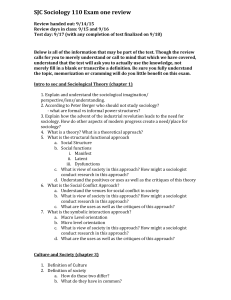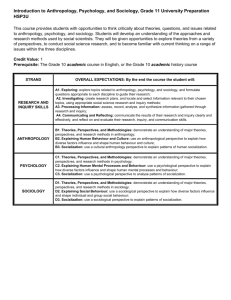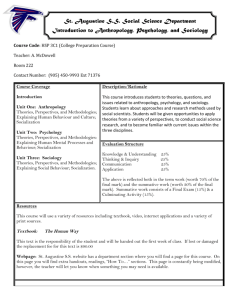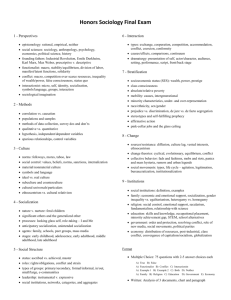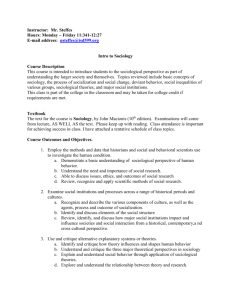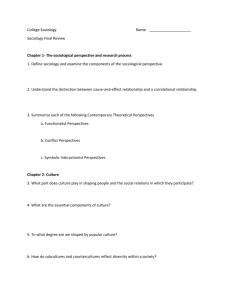Specific Curriculum Outcomes
advertisement
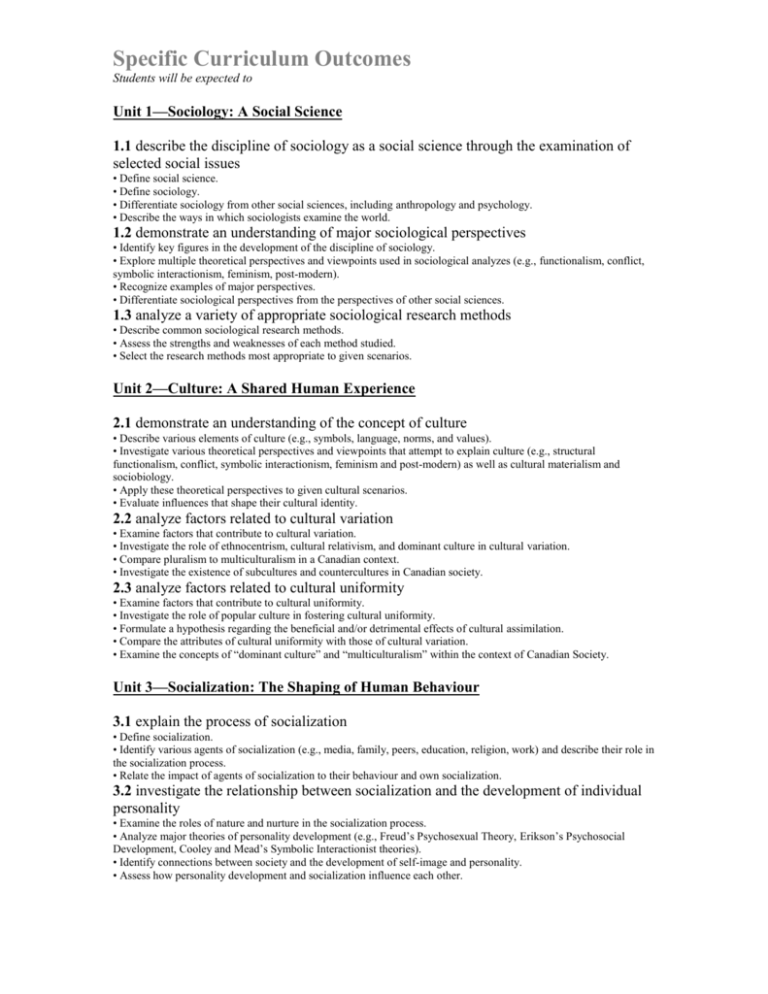
Specific Curriculum Outcomes Students will be expected to Unit 1—Sociology: A Social Science 1.1 describe the discipline of sociology as a social science through the examination of selected social issues • Define social science. • Define sociology. • Differentiate sociology from other social sciences, including anthropology and psychology. • Describe the ways in which sociologists examine the world. 1.2 demonstrate an understanding of major sociological perspectives • Identify key figures in the development of the discipline of sociology. • Explore multiple theoretical perspectives and viewpoints used in sociological analyzes (e.g., functionalism, conflict, symbolic interactionism, feminism, post-modern). • Recognize examples of major perspectives. • Differentiate sociological perspectives from the perspectives of other social sciences. 1.3 analyze a variety of appropriate sociological research methods • Describe common sociological research methods. • Assess the strengths and weaknesses of each method studied. • Select the research methods most appropriate to given scenarios. Unit 2—Culture: A Shared Human Experience 2.1 demonstrate an understanding of the concept of culture • Describe various elements of culture (e.g., symbols, language, norms, and values). • Investigate various theoretical perspectives and viewpoints that attempt to explain culture (e.g., structural functionalism, conflict, symbolic interactionism, feminism and post-modern) as well as cultural materialism and sociobiology. • Apply these theoretical perspectives to given cultural scenarios. • Evaluate influences that shape their cultural identity. 2.2 analyze factors related to cultural variation • Examine factors that contribute to cultural variation. • Investigate the role of ethnocentrism, cultural relativism, and dominant culture in cultural variation. • Compare pluralism to multiculturalism in a Canadian context. • Investigate the existence of subcultures and countercultures in Canadian society. 2.3 analyze factors related to cultural uniformity • Examine factors that contribute to cultural uniformity. • Investigate the role of popular culture in fostering cultural uniformity. • Formulate a hypothesis regarding the beneficial and/or detrimental effects of cultural assimilation. • Compare the attributes of cultural uniformity with those of cultural variation. • Examine the concepts of “dominant culture” and “multiculturalism” within the context of Canadian Society. Unit 3—Socialization: The Shaping of Human Behaviour 3.1 explain the process of socialization • Define socialization. • Identify various agents of socialization (e.g., media, family, peers, education, religion, work) and describe their role in the socialization process. • Relate the impact of agents of socialization to their behaviour and own socialization. 3.2 investigate the relationship between socialization and the development of individual personality • Examine the roles of nature and nurture in the socialization process. • Analyze major theories of personality development (e.g., Freud’s Psychosexual Theory, Erikson’s Psychosocial Development, Cooley and Mead’s Symbolic Interactionist theories). • Identify connections between society and the development of self-image and personality. • Assess how personality development and socialization influence each other. Specific Curriculum Outcomes Students will be expected to 3.3 investigate the relationship between socialization and the process of human learning • Examine various theories of human learning (e.g., Piaget’s Cognitive Development Theory, Erikson`s Psychological Development, Kohlberg’s Moral Development Theory, and Gilligan’s Theory on Gender and Moral Development. • Evaluate various theories of human learning (e.g., Piaget’s Cognitive Development Theory, Erikson`s Psychological Development, Kohlberg’s Moral Development Theory, and Gilligan’s Theory on Gender and Moral Development. • Formulate a hypothesis as to which theory(ies) of human learning best characterize their learning. • Assess how human learning and socialization influence each other. Unit 4—Social Organization: Living Together as Humans 4.1 describe the role of groups in the organization of human societies • Identify different types of groups. • Describe ways in which groups shape human behaviour. • Investigate the role of groups in the evolution of human societies. 4.2 examine the role of social stratification in the organization of human societies, in relation to gender, race, and socio-economic status • Define social stratification and its related concepts (i.e., status and role). • Apply appropriate theories to the concept of social stratification. • Formulate a hypothesis regarding positive and negative implications of social stratification in a society. • Investigate examples of the relationship between stratification, power, and inequality. 4.3 examine the role of social institutions in the organization of human societies • Describe the characteristics of a social institution. • Apply appropriate theories to the concept of social institutions. • Analyze examples of social institutions, including the family. • Evaluate the contribution of social institutions to social organization. Unit 5—Social Control: Deviant and Conformist Behaviour 5.1 analyze ways in which societies exercise social control to achieve conformity • Apply appropriate theories to the concept of conformity. • Distinguish between formal and informal methods of social control. • Assess the effectiveness of various methods of social control. • Investigate the evolution and effectiveness of the modern corrections system. 5.2 investigate deviance as a form of social behaviour • Define the concept of deviance. • Compare how diverse cultures define, and respond to, deviance. • Apply appropriate theories to the concept of deviance. • Evaluate the positive and negative implications of deviant behaviour in a society. 5.3 investigate the issue of crime as an example of deviant behaviour • Distinguish between legal and sociological approaches to the study of crime. • Outline the sociological framework for the classification of crime. • Describe the social factors that contribute to the occurrence of crime. • Apply the sociological analysis of crime to current examples of criminal behaviour in Canadian society.
